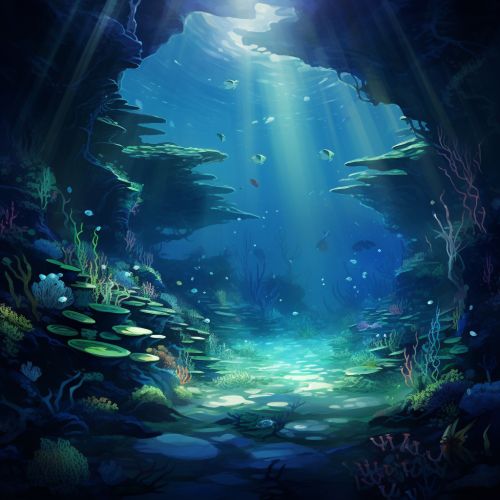The Ecology of Deep Ocean Bioluminescence
Introduction
Deep ocean bioluminescence is a fascinating phenomenon that occurs in the darkest depths of the world's oceans. It refers to the ability of certain marine organisms to produce and emit light. This light is generated through a chemical reaction that takes place within the organism, involving a molecule called luciferin, an enzyme known as luciferase, and oxygen. The resulting emission of light can be used for a variety of purposes, including communication, predation, and defense. This article will delve into the ecology of deep ocean bioluminescence, exploring the organisms that possess this ability, the environments in which they live, and the ecological roles and implications of bioluminescence in the deep sea.


Bioluminescent Organisms
Many different types of organisms in the deep sea have the ability to produce light, including bacteria, dinoflagellates, squid, fish, and jellyfish. These organisms span a wide range of sizes and ecological roles, from tiny bacteria that live symbiotically within larger organisms, to large squid and fish that use light to communicate and hunt.
Bacteria
Bioluminescent bacteria are perhaps the most common type of light-producing organisms in the deep sea. They are often found living in symbiotic relationships with larger organisms, such as squid or fish. The bacteria provide light for the host organism, which in turn provides the bacteria with a protected environment and nutrients.
Dinoflagellates
Dinoflagellates are single-celled organisms that are capable of producing light. They are often responsible for the glowing waves seen in certain coastal areas at night. In the deep sea, bioluminescent dinoflagellates can be found living freely in the water column or in association with other organisms.
Squid
Many species of squid in the deep sea are capable of bioluminescence. They use light for a variety of purposes, including communication, camouflage, and hunting. Some species have specialized light organs, called photophores, which can produce light of different colors and intensities.
Fish
There are many species of deep-sea fish that are capable of bioluminescence. These include the anglerfish, which uses a bioluminescent lure to attract prey, and the lanternfish, which uses light for camouflage and communication.
Jellyfish
Several species of deep-sea jellyfish are capable of bioluminescence. They use light for defense, by startling predators, and for predation, by attracting prey with their glowing bodies.
Deep Sea Environment
The deep sea is a challenging environment for life. It is characterized by high pressure, low temperatures, and complete darkness below a depth of about 1000 meters, known as the aphotic zone. Despite these harsh conditions, a diverse array of organisms have adapted to survive and thrive in the deep sea, many of which utilize bioluminescence.
Pressure
The pressure in the deep sea increases by approximately one atmosphere for every 10 meters of depth. This high pressure can have significant effects on the biochemistry and physiology of deep-sea organisms, including those that produce light.
Temperature
The temperature in the deep sea is typically between 2 and 4 degrees Celsius. This cold environment can slow down metabolic processes and affect the efficiency of bioluminescent reactions.
Darkness
Below the aphotic zone, there is no sunlight. This complete darkness has led to the evolution of many unique adaptations in deep-sea organisms, including the widespread use of bioluminescence.
Ecological Roles of Bioluminescence
Bioluminescence plays several important ecological roles in the deep sea. These include communication, predation, and defense.
Communication
Many deep-sea organisms use bioluminescence for communication. For example, some species of squid and fish use light signals to communicate with potential mates or rivals.
Predation
Bioluminescence is also used for predation in the deep sea. Some organisms, like the anglerfish, use a bioluminescent lure to attract prey. Others, like certain species of squid, use light to stun or disorient their prey.
Defense
Bioluminescence can also serve as a defense mechanism in the deep sea. Some organisms use light to startle or distract predators, while others use it to camouflage themselves against the faint light coming from above.
Implications of Bioluminescence
The widespread use of bioluminescence in the deep sea has several implications for our understanding of life in this extreme environment.
Evolution
The prevalence of bioluminescence in the deep sea suggests that this trait has been highly favored by natural selection. This could be due to the many advantages that light production offers in an environment where visibility is limited.
Biodiversity
Bioluminescence is thought to contribute to the high biodiversity found in the deep sea. By providing a means of communication and predation in the dark, bioluminescence may allow for more niche specialization and thus greater diversity of species.
Human Applications
Bioluminescence has potential applications for human society. For example, the enzymes involved in bioluminescent reactions could be used in medical and scientific research. Additionally, studying bioluminescence can help us understand how life can adapt to extreme environments, which could have implications for the search for life on other planets.
